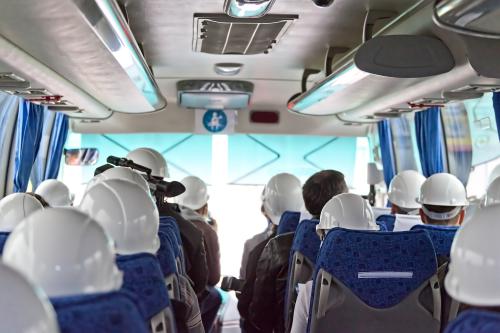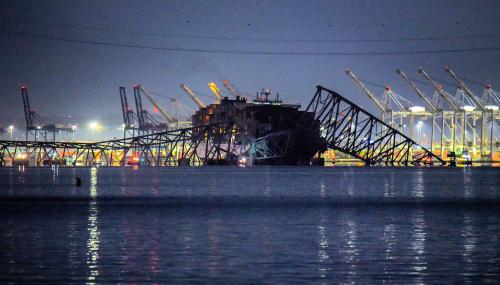If the country had a dashboard for economic health, most signs would point positive: unemployment down, median wages finally rising, consumer confidence strong.
Yet amid all the good news, fallout from trade tariffs are contributing to rising fears of economic unrest. Every community in the country relies on trade to some degree, putting agricultural exporters, retail importers, and many other industries at risk of higher prices, disrupted supply chains, and a loss of market power.
While trade may touch producers and consumers in every corner of the country, the physical act of international exchange is a highly concentrated activity. Even with hundreds of border crossings, airports, and seaports, only a small group of places process most of the country’s international goods. As a result, these facilities are both essential connections to the world and major economic anchors in their local communities.
The growing trade war now poses a genuine economic threat to this small set of port-focused metro areas. If tariffs depress total trade, these ports could see reductions in business activity—leading to decreased labor hours, rising fiscal challenges, and an overall drag on local economic growth. The urgency is only increasing as China formalizes a third round of tariffs and the Trump administration threatens further retaliatory action.
Using trade volume information from PIERS and the U.S. Census Bureau, plus labor market data from EMSI, we gauged how international tariff adjustments, including those imposed under Section 232 (affecting steel and aluminum imports) and Section 301 (affecting trade of certain products with China), could affect trade and port-related employment in metro areas. Four key findings stand out:
1. In 2017, $221 billion of seaborne cargo was exposed to recently adjusted tariffs, accounting for nearly 10 percent of all goods moved through U.S. seaports that year.
The U.S. is one of the largest seaborne traders in the world, moving over $2.2 trillion in exports and imports across more than 170 different ports in 2017 alone. Like the U.S. as a whole, these seaports also reflect a trade imbalance between imports ($1.3 trillion) and exports ($0.9 trillion).
American consumers have been far more exposed than American exporters to tariff adjustments thus far. Higher retaliatory tariffs only impact $49.5 billion of U.S. seaborne exports, equal to about 5.4 percent of all exported seaborne value in 2017. By contrast, U.S. tariffs expose about $171.7 billion in seaborne imports, or 13.1 percent of all imported seaborne value in 2017.
Some of the major commodities exposed to these tariffs include various plastics, machines, and appliances imported from China (under Section 301), as well as several aluminum and steel products imported from countries ranging from India to Mexico (under Section 232). As international peers respond to escalations in this ongoing trade war, America’s exported commodities will only be hit harder.
2. Tariff impacts are concentrated in a small number of U.S. seaports, with 20 ports absorbing 94 percent of these impacts.
Even with over 170 different seaports across the country, U.S. seaborne trade is highly concentrated in a relatively small number of seaports. Some of this has to do with equipment capacity, exemplified by the container cranes visible in large ports. It also has to do with commodity specialization based on local equipment, like oils and chemicals facilities at Gulf Coast ports or grain elevators in Portland, Ore.
This concentration leads to high levels of tariff exposure in a relatively small number of places: 20 ports spread across 18 metro areas move 94 percent of all commodities that could be impacted by tariffs. The biggest ports face the brunt of these tariffs. Los Angeles, Long Beach, Calif., and New York City combine to move almost 50 percent of all tariff-related commodities by value, and the next seven most-exposed ports move more than another 30 percent of national value.
The geography of total tariff exposure represents a kind of road map to American trade. Our nation’s large appetite for imported consumer goods implicates the California ports and metro Seattle’s two ports. Most Atlantic ports also specialize in various consumer-focused goods. Gulf Coast ports—especially those near Houston, New Orleans, La., and Mobile, Ala.—specialize in commodities like iron, glass, and various machine parts.

3. Many of the largest tariff-exposed ports could see between 10 and 25 percent of their trade volume impacted.
Depending on how businesses and households respond to higher-priced goods, recently adjusted tariffs could affect considerable shares of current activity at many of the country’s largest ports. The three largest California ports—Los Angeles, Long Beach, and Oakland—could all see roughly 20 percent of their trade volumes impacted. Seattle and Tacoma, Wash. have the same level of exposure. Meanwhile, in most of the major east coast ports—including New York; Baltimore; Norfolk, Va.; Charleston, S.C.; and Savannah, Ga.—10 to 17 percent of total trade volume may be affected.
Yet even for some of the country’s smaller seaports, tariff exposures are significant relative to their local operations. For example, over 20 percent of traded value at ports in Chicago and Vancouver, Wash. is in goods impacted by higher tariffs. Operators at these relatively smaller ports are rightly concerned with what tariffs could mean for their business.

4. The trade war leaves the country’s port-related labor force in a tenuous position, with hundreds of thousands of workers carrying out activities that could be reduced or eliminated.
While there is no clear or consistent definition of how many workers are employed across all of the country’s seaports—including related warehousing, trucking, and shipping firms—there are at least 129,000 workers employed directly within seaborne establishments, according to standard industry definitions. Research using broader definitions suggests more than 400,000 workers nationwide are directly employed in activities related to seaborne trade, ranging from business specialists to offsite truck drivers. While it’s difficult to know exactly how many workers directly tie into seaborne trade in any given place, we use local employment figures and this national 1:4 ratio to estimate direct employment exposure.
Overall, port employment mirrors the concentration of trade volumes, meaning a small set of metro areas account for a disproportionate share of jobs directly related to seaborne trade. And since many of those same ports face the highest tariff exposure, their sizable labor forces could bear the brunt of any tariff-induced declines in trade.
Among direct jobs, most locally exposed jobs are in the country’s biggest port metro areas, including almost two-thirds in the 10 largest ports alone. Led by Los Angeles (14 percent), Miami (12 percent), Houston (9 percent), and New York (6 percent), these ports house tens of thousands of laborers, drivers, and operators directly responsible for processing cargo. Nationally, even greater numbers of workers depend directly on the traded commodities that flow through these ports (Table 1).

Port metro areas must prepare for fallout from tariff-induced trade reductions
While today’s trade war is largely driven in Washington, D.C. and reconciled at factories and checkout counters across the country, ports have little defense from becoming collateral damage. They are the backbone of international trade flows, leaving them deeply exposed to international negotiations and market responses outside their control.
That starts with port-related employment. Port jobs are tradable, meaning they sell services to outside markets (both domestic and international) and bring new income into their home metro areas. As such, they’re essential to growing local economies. Any reductions in their employment levels will be felt both by the port-related workers and all the support services they rely on, like local retail industries. In other words: expect drags on local economic output. This makes it all the more important for port leadership, plus public and private economic development staffers, to closely follow what’s happening locally.
There is also a role for state and federal leadership. Trade adjustment programs often look at workers and communities impacted by changing trade patterns. Seaborne trade easily fits that bill, and the geographically-focused impacts mean specific metro areas have a case to receive attention as policymakers consider modernizing such programs. As the trade war continues to evolve and perhaps escalate, policymakers must closely monitor market responses by consumers, producers, and ports to determine who’s paying the economic price, and how best to alleviate it.







Commentary
A handful of ports and their workers bear the brunt of retaliatory tariffs
November 28, 2018